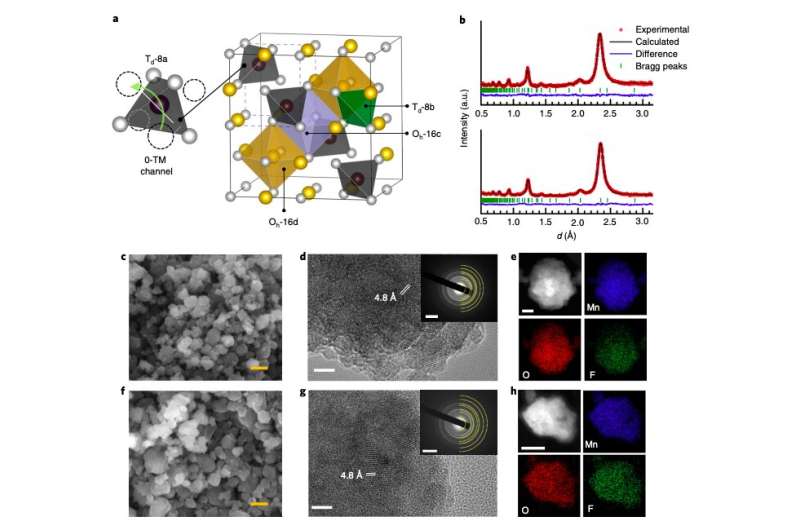March 20, 2020 feature
A strategy to achieve ultrahigh power and energy density in lithium-ion batteries

In recent years, lithium-based batteries have become widely used to power a wide range of electronic devices, including tablets, smart phones and portable computers. These batteries have different compartments, called cells, each of which contains a positive electrode and a negative electrode separated by a chemical known as an electrolyte.
Positive electrodes are generally composed of lithium compounds, such as LiCoO2 or LiFePO4, while negative electrodes are usually made of carbon. The electrolyte separating them, on the other hand, can be made of a variety of chemical substances.
In light of the rapid growth in the use of lithium-ion batteries, researchers worldwide have been trying to identify materials that could increase their efficiency and performance. Ideally, these materials should contain elements that are abundant on the planet and have a high energy density.
Researchers at University of California Berkeley and the Lawrence Berkeley National laboratory have recently introduced a new strategy for designing electrode materials for lithium-based batteries with a remarkably high power and energy density. This strategy, outlined in a paper published in Nature Energy, entails the use of two bulk oxyfluorides with a partial spinel-like order, namely Li1.68Mn1.6O3.7F0.3 and Li1.68Mn1.6O3.4F0.6. The researchers synthesized these two oxyfluorides using a technique known as mechanochemical alloying.
"We show that combining a partial spinel-like cation order and substantial lithium excess enables both dense and fast energy storage," the researchers wrote in their paper. "Cation overstoichiometry and the resulting partial order is used to eliminate the phase transitions typical of ordered spinels and enable a larger practical capacity, while lithium excess is synergistically used with fluorine substitution to create a high lithium mobility."
The approach for designing cathode materials introduced by the researchers has so far proved to be highly promising. In a series of preliminary experiments, the resulting cathodes achieved remarkable energies of over 1,100 Wh kg-1, discharge rates up to 20 A g-1 and a capacity above 360 mA h g-1, , which is among the highest reported so far. Moreover, a large part of this capacity was maintained over time, even when the batteries were recharged several times.
Interestingly, almost half of the capacity resulted from a process known as oxygen redox (i.e., oxidation reduction). While this phenomenon has been widely investigated in Li-rich layered Ni-Mn-Co oxides or in disordered rock-salts, it has rarely been observed in spinel-type cathodes such as the ones synthesized by the researchers.
In their experiments, the researchers were also able to optimize cation overstoichometry and Li excess, two chemical qualities that can help to tune the structure of electrode materials. This allowed them to achieve a number of desirable cathode characteristics such as fast Li transport kinetics and excellent voltage profiles.
In the future, the design strategy could serve as a guideline for the realization of cathode materials for lithium-based batteries with high power and energy densities. Moreover, the two oxyfluorides synthesized in their study could be used to create new, highly performing batteries.
More information: Huiwen Ji et al. Ultrahigh power and energy density in partially ordered lithium-ion cathode materials, Nature Energy (2020). DOI: 10.1038/s41560-020-0573-1
© 2020 Science X Network


















